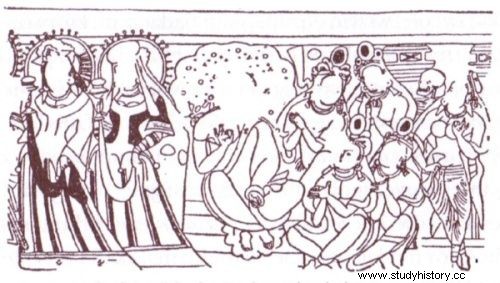In 1905, a German expedition to Chinese Turkestan, led by Albert von Le Coq, discovered surprising frescoes from the 6th-7th centuries CE in Kyzyl. They depicted the Tochars - the people who lived in this region of China at that time. There would be nothing strange about them, if not for the fact that the characters' costumes resembled ... the costumes of medieval and modern Europeans.
Le Coq, a professor at the National Museum of Ethnology in Berlin, described the moment of entering the excavated Buddhist temple as follows:
At first glance, the paintings of the donors reminded us of paintings from Gothic cemetery chapels. The men were standing here on their legs wide apart (…). Their long caftans made of brocade or wonderfully embroidered had triangular lapels. They wore princely belts of metal discs and dangling from them long, straight swords with a cross-hilt and a rounded or flattened knob, and they were amazingly similar to European swords of the Carolingian and early Gothic era . On the other sides they wore Scythian daggers (...).
There were women standing near the princes, all dressed in tight-fitting bras cut deep in the front, with bell-shaped sleeves (…). They wore long skirts with trains, and their postures remind us of those moving poses of women, with arms tilted back and body forward, as we often see in European painting from Holbein to Van Dyck. (...) This comparison of women's clothing and men's weapons shows a striking and remarkable similarity.
Of course, with each play, there is a lot of room for interpretation - one observer will see a European caftan, another plain steppe outfit. Anyway, have a look at the reconstructions of Kyzyl frescoes from the book by Aleksandra and Edward Kajdański entitled "Silk. Trails of junks and caravans ”. Do you see such a great similarity?

Fragments of another fresco from Kyzyl. More examples can be found in the book by Aleksandra and Edward Kajdański.
However, if there was something to do (apart from the usual association), how exactly could Chinese elements of costumes and design motifs get to the other side of the world?
According to the Kajdański family, the steppe peoples have brought a new fashion to Europe and all kinds of "barbarians" - Huns, Germans, Scyths or even Celts. It was from them that the Asian style was to be taken over by, for example, the Franks of the Merovingian era or the Carolingians, mentioned by Le Coq.
Source:
- A. Kajdańska, E. Kajdański, Jedwab. Junk and caravan trails , Book and Knowledge 2007.
